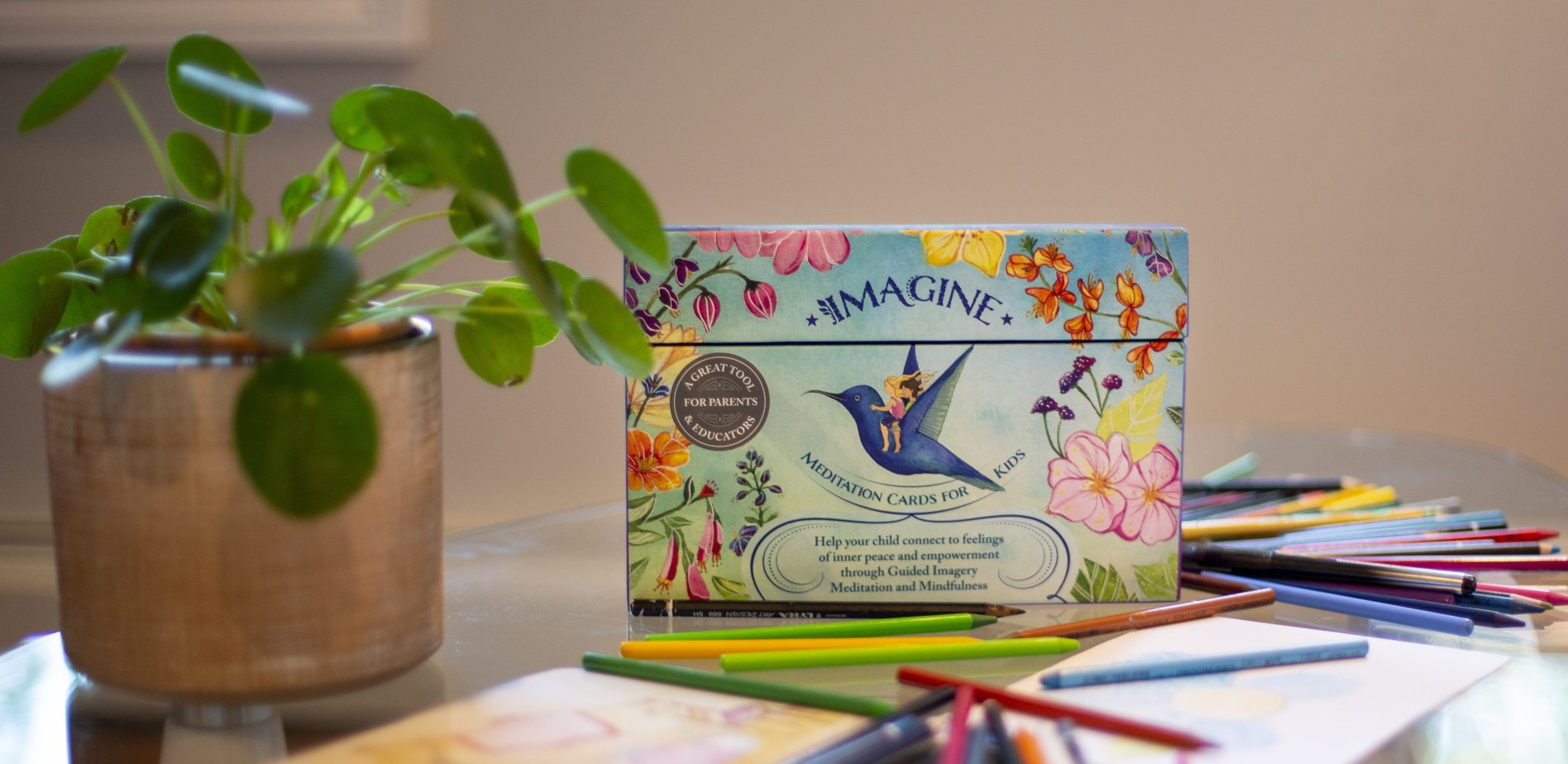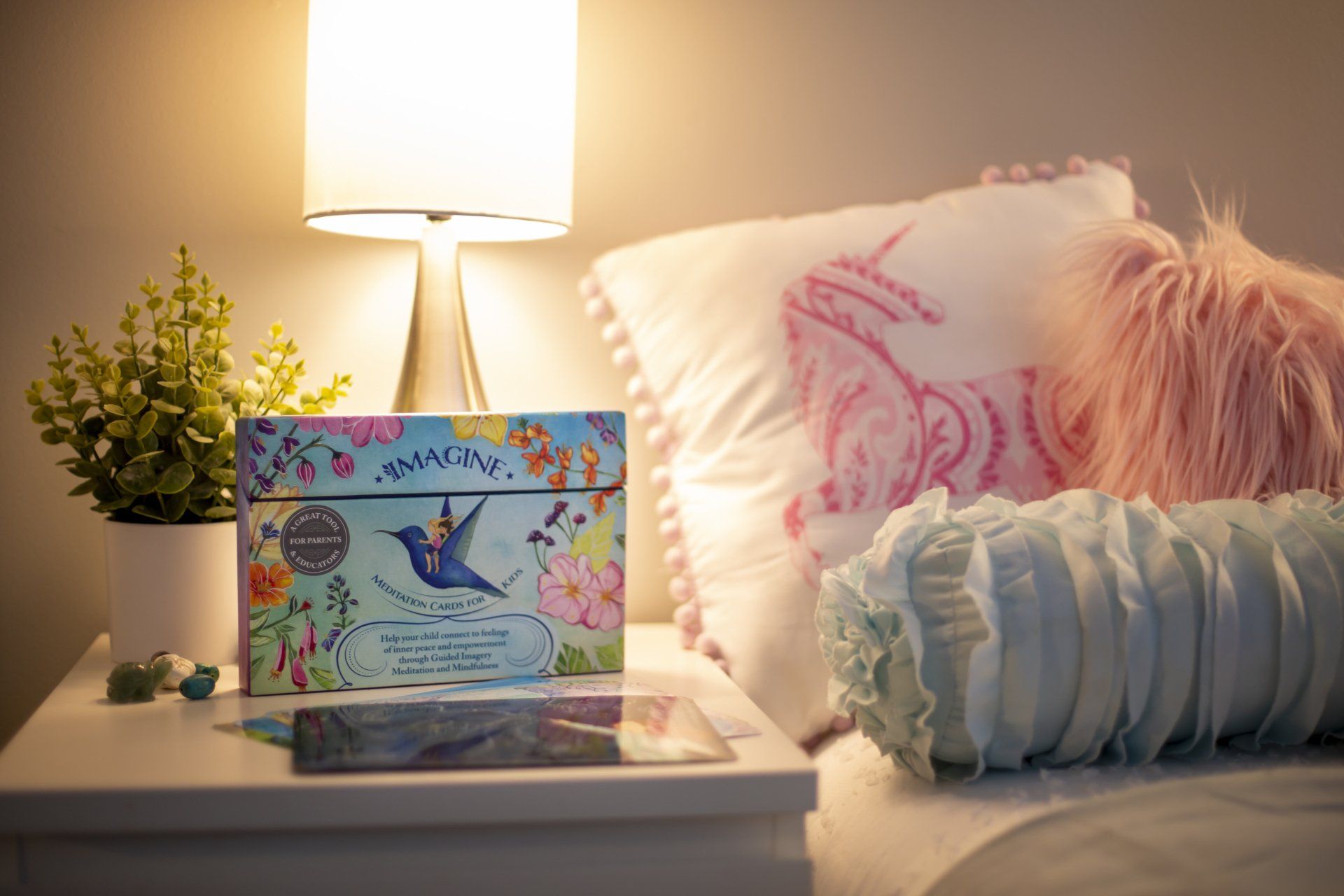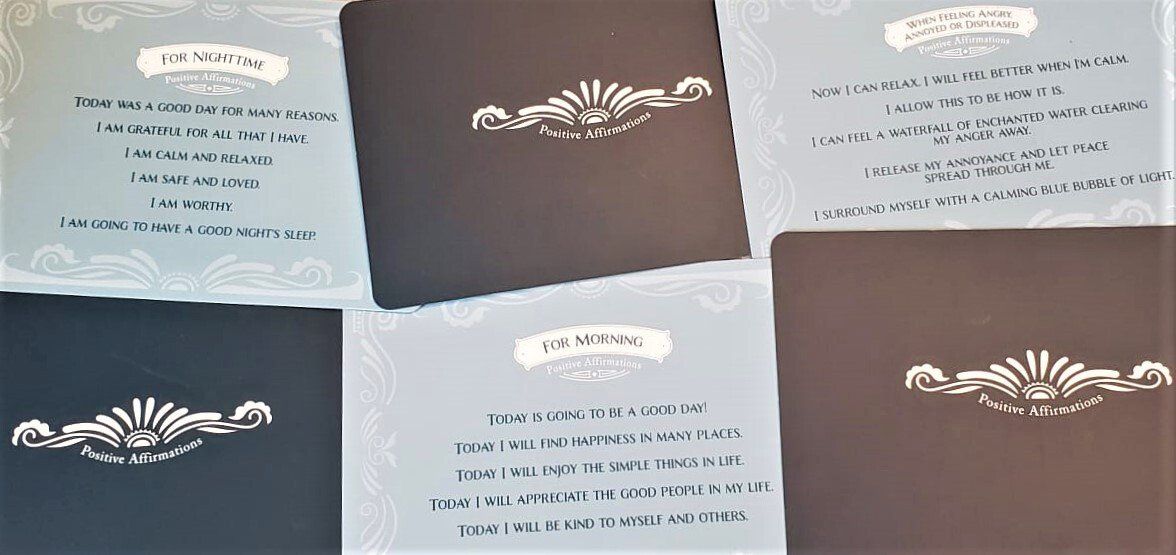The Dolphin - a sneak peek into one of the meditation cards
The Imagine Team • March 4, 2020
“Close your eyes… Imagine you are walking barefoot on a perfect beach in a beautiful bay… The sand under your feet is damp and cool… The sunlight is gentle and warm… You can smell the ocean breeze… You look at the seawater, take a deep breath and fill your body with the beautiful blue colors of the ocean ... The seawater is calm, small waves are making their way to shore …”
The Dolphin meditation card is an open invitation for kids to come and enjoy a relaxing and fun experience for their body and mind. With the first sentence, as they imagine “walking barefoot on a perfect beach in a beautiful bay,” their mind begins to experience positive sensations, sending the same soothing message to their body.
Imagining the damp and cool sand under their feet, feeling the gentle warmth of the sun, smelling the ocean breeze - these descriptions are all about awakening their senses to support this imaginary landscape, and make it feel as real as if they were actually there. We know that our body follows our thoughts without judgement, whether these thoughts reflect reality or not. Our goal here is to have them imagine that calm and pleasant sensation, creating peace of mind that their whole body will experience.
“You take another deep breath and feel as if a picture of this fabulous beach is reflected inside your body, making you very relaxed ...”
When kids imagine the picture being reflected in their body, it prompts them to internalize what they see and how they feel. As a result, it will become more tangible for them, and thus easier to retrieve the next time they meditate with this card, or at any other time they’d like.
“You then notice the sweetest dolphin in the shallow water ... She is smiling at you, and you smile back ... She wants to play with you! ... You step into the warm water and walk towards her ... She comes closer to you, and you pat her head ... Her skin feels so soft ... You gently pat her back … She makes wonderful and cheery dolphin sounds ... So, you answer with similar sounds too …”
Dolphins are known to be playful and happy animals, offering positive feelings and enjoyment. This positivity is what we are looking for our kid to experience with the sweet, imaginary dolphin. Feeling the dolphin’s soft skin, hearing her cheery sounds, and making sounds similar to hers can all help our kid create a vivid impression in his or her mind’s eye.
“You start swimming side by side in the peaceful bay ... The dolphin offers that you hold on to her back fin, and go on a wonderful ride together ... You are having so much fun ... You feel so alive! … The water feels so good and refreshing, with so many shades of blue and green ... The dolphin tells you of her many adventures in the blue waters of the ocean …”
At this stage, our kids can take another step into the imagined sensory experience. Now they feel the water, their motion through it, and their hold to the dolphin. Adding the blue and green colors of the ocean helps them remain in that magical moment by painting the imaginary scene with fine details. When the dolphin tells them of her many adventures in the blue water of the ocean it’s another invitation to go further and imagine what all those wonderful adventures could be. It also invites our kids to make the experience more personal by incorporating their personal vision.
“When the sun sets, it is time to return home ... You thank the dolphin for the most amazing time you had together ... You walk out of the water ... and look back to your smiling dolphin ... You know that you can always come back for another magical swim with your precious dolphin.”
When guiding kids through this encounter, keeping the meditation short is a key to success. They will have gone through so much during these few moments and had such an amazing experience in their imagination; at this stage they have received a good message, so there’s no need to push it further. :)
I believe that a good way to end a guided meditation is to make an acknowledgement of gratitude. Here, kids could do this by thanking the dolphin for the wonderful time they had together. Also, a good thing to mention before ending the meditation is that they are always welcome to come back again to that magical place. In this case, the dolphin is always available for another fun ride!
The Imagine Blog

In my last blog I discussed the everyday challenge of going to sleep and how a simple bedtime routine can be a HUGE help. So now a little more into detail with these great ways to make it work! Phase One – Taking Care of the Body Try dedicating the first 10 minutes of the routine to basic actions that prepare the body for hopping into bed, such as brushing teeth, getting into pjs, and snagging a glass of water. Do your best to make sure these happen at about the same time and, if possible, in the same order. And don’t forget to include a cut-off time for electronics – at least 30 minutes before it’s time to fall asleep. Blue light has been shown to limit production of melatonin, a hormone that’s key to maintaining a healthy sleep cycle. Avoiding electronics right before bedtime will help kids fall asleep faster and wake up feeling rested. Once all of this is out of the way, you can move on to the next phase of the routine. Phase Two – Taking Care of the Heart and Mind The second phase, in my opinion, is the best part of the routine, and it actually offers a priceless opportunity for you to create a 100% nurturing experience for your kids . In fact, the content you pour into the next 10 minutes or so will have a life-long effect on them. There are a ton of different things you can do to treasure your time together. You can… Read a book Take turns saying things you’re grateful for Talk about the good things that happened that day Sing a song or say a prayer Say goodnight to family members, friends, the moon, the stars, the birds, or even the trees outside The Guided Imagery Meditation Option If you haven’t before, you could also give guided imagery meditation a try! You might be surprised how fun and calming it is to visualize a pleasant scene as if you’re part of it. There are many different types of meditation you can do depending on your preference: breathing practice, progressive relaxation, mindfulness meditation focused on the five senses, landscape visualization, self-esteem exercises… And the list goes on! Get started with one of my guided imagery meditation scripts: The Protection Bubble . Then you can branch out based on your success. (Many of my customers swear by bedtime meditation!) Keep it short so bedtime remains as consistent as possible, but don’t be in a hurry. Above all, make sure to be present. These are some of life’s most precious moments, so just relax into the bonding experience. The more you give, the more you’ll receive during these positive, soothing 10 minutes. Oh, and try not to blink… They’ll be all grown-up so fast! :)

“My kids always go to sleep so nice and easy!” said no parent ever. Getting your kids to go to sleep every night can be quite difficult, wouldn’t you agree? When my kids were young, I used to feel like I could fall asleep a hundred times before they ever did. And by the time the house was quiet, I was running on fumes. The Challenge – Encouraging the Kids to Sleep Unfortunately, falling asleep is not something that children can do on command, and it can get frustrating for all parties involved when they struggle with bedtime. The good news is that following a regular bedtime routine can turn that difficulty into willingness and even, dare I say, anticipation. Not only does a solid routine help to bring each day to a close in a positive way, but it also contributes to better sleep at night. This will have a great impact on your children’s health and well-being, not to mention your own... Still skeptical that it’s even possible? Perhaps that’s because you’ve never given guided meditation a try. ;) But before we get into that, let’s talk a little bit about the basics of bedtime. The Road to Success – Creating a 20-minute Bedtime Routine All good bedtime routines are built on a few similar and repetitive activities that occur every night at around the same time. But making the routine predictable does not mean it has to be dull (even though that can help with the process of winding down). The magic lies in creating a familiar and foreseeable space that kids associate with going to sleep. This provides young, active kids with a sense of security that gradually allows them to let go of the day and welcome a good night. Best of all, a bedtime routine doesn’t need to be long! About 20 minutes will do for a soft landing :) In my next blog - an easy two-phase process for a successful and fun bedtime routine.

“ I am smart and capable. I am kind. I am confident. ” Could something so simple actually work? Absolutely, yes! And when it comes to managing thoughts and feelings, it doesn’t get much easier than positive affirmations. What Are Positive Affirmations Positive affirmations are simple, short sentences with motivating or reassuring content that you can repeat to yourself in order to improve your mood or mindset. An easy yet powerful stress management tool, positive affirmations can be applied to any aspect of life to increase your confidence and help you feel good. When used often enough, they can have a real and lasting effect on the way you naturally think and behave. Tips to Maximize Your Affirmations Say the words “I am” in your positive affirmations. Doing so helps to create a more favorable state of mind – one in which you feel connected to the emotions you want to promote. Focus on the present. Sticking to present-tense statements makes them feel more real and attainable. There’s no need to worry about whether the affirmation will come true because you’re telling yourself it already is. Be specific about your wording. Statements that affirm the feelings you want, such as “I am courageous,” are more impactful than statements that negate your current feelings, like “I am not scared.” Using Positive Affirmations With Kids The wonderful thing about positive affirmations is that there is no limit to their usefulness – especially when it comes to kids. Kids encounter so many different situations each day that test their skills and emotions. Here are just a few examples of times when you can try positive affirmations with your child: First thing in the morning, to start each day with a positive mindset At bedtime, to ease their transition to a restful sleep When facing a test at school or any other kind of personal challenge When feeling an overwhelming emotion, such as stress, anger, or sadness What Positive Affirmations Are Not Positive affirmations are a great tool to train the mind toward positive thinking and emotional regulation. But it is worth noting that all emotions are valid and serve a purpose. Kids should know that it is absolutely OK to feel whatever emotion they are feeling. It’s OK to be sad, angry or stressed, and it is OK to feel overwhelmed. Positive affirmations are not a tool to erase negative feelings altogether, since there are times when those emotions are healthy and necessary. This message can be especially helpful to kids, who tend to see things in black and white. That said, positive affirmations are great any time a person decides they’d like to transition to a new mindset. So next time you or your child feel the need to turn things around, give these tips a try. Sometimes, all it takes is a simple “I am OK right now.”
